Xanthone as Antimalarial: QSAR Analysis, Synthesis, Molecular Docking and In-vitro Antimalarial Evaluation
Jufrizal Syahri1,2, Emmy Yuanita2,3, Beta Achromi Nurohmah2, Muhammad Hizbul Wathon4, Rahmadini Syafri1,Ria Armunanto2 and Bambang Purwono2
1Department of Chemistry, UniversitasMuhammadiyah Riau – Indonesia.
2Department of Chemistry, UniversitasGadjahMada - Indonesia.
3Department of Chemistry, UniversitasMataram – Indonesia.
4School of Chemistry, University of Leeds – United Kingdom.
Corresponding Author E-mail: purwono.bambang@ugm.ac.id
DOI : http://dx.doi.org/10.13005/ojc/330104
Article Received on :
Article Accepted on :
Article Published : 06 Feb 2017
The rational design of eighteen new antimalarial compounds from xanthone derivatives has been conducted based on Quantitative Structure-Activity Relationship(QSAR) calculation using semi-empirical AM1 methods. The best equation model obtained from QSAR calculation was Log pIC50 = 2.997 - 29.256 (qO8) - 138.234 (qC9) - 6.882 (qC12) - 107.836 (qC14) + 48.764 (qO15). Among the designed compounds, 3,6-dihydroxy-9H-xanthen-9-one (26) and 3,4,6-trihydroxy-9H-xanthen-9-one (27) have been synthesized and investigated their in-vitro antimalarial activities against the chloroquine-sensitive 3D7 strain. An in-vitro antimalarial activity of compound 26 and 27 showed to be highly potential as antimalarial compounds with IC50 of 0.71 and 0.11 µM respectively. Molecular docking studies of compound 26 and 27 showed the formation of a binding interaction between the compounds with the amino acids Ala16, Ser108, Phe58, Asp54 and Leu46, which is the crucial amino acids for antimalarial activity based on the protein-ligand co-crystal structure of WR99210(1,3,5-triazine, a pre-clinical molecule as P. falciparum DHFR-TS inhibitor).
KEYWORDS:Antimalarial; Docking; Semi-empirical AM 1; QSAR; Xanthone
Download this article as:| Copy the following to cite this article: Syahri J, Yuanita E, Nurohmah B. A, Wathon M. H, Syafri R, Armunanto R, Purwono B . Xanthone as Antimalarial: QSAR Analysis, Synthesis, Molecular Docking and In-vitro Antimalarial Evaluation. Orient J Chem 2017;33(1). |
| Copy the following to cite this URL: Syahri J, Yuanita E, Nurohmah B. A, Wathon M. H, Syafri R, Armunanto R, Purwono B . Xanthone as Antimalarial: QSAR Analysis, Synthesis, Molecular Docking and In-vitro Antimalarial Evaluation. Orient J Chem 2017;33(1). Available from: http://www.orientjchem.org/?p=29819 |
Introduction
There are five types of malaria parasites that commonly infect humans, the first one is Plasmodium falciparum, which is the most fatal among otherPlasmodium parasites. Furthermore, Plasmodium vivax,Plasmodium ovale, and Plasmodium malariaethat cause mild diseases in human and not generally fatal. The fifth parasite, Plasmodium knowlesi, is known to cause malaria in monkeys, which is reported can also infect humans. According tothe WHO report in 2015, mortality number caused by malaria disease of as many as 438,000 lives from 214 million cases of malaria infection in the world.1
Parasite resistanceto the antimalarial drugs such as chloroquine and artemisinin has led to the high number of dead.2-3 In order to prevent more victims caused by malaria disease, searching and finding for new candidates of the antimalarial drug must be conducted continuously because the absence of new antimalarial drugs may cause malaria being an uncured disease in the next ten years.One of the strategies to find new antimalarial drugs is to explore natural products, particularly from plants, which have been traditionally utilized as an antimalarial drug. Xanthone, as one of the secondary metabolite compounds from nature, has been reported to have antimalarial activity.4-6However, further research to find optimum antimalarial activities of xanthone compounds is still needed. Hence, the research to discover xanthone compounds with the best antimalarial activity should be conducted.
Xanthone compound was also reported for having some activities as anticancer,7-9 antitumor,10-11 antioxidant,12-13 cytotoxic,14-16 leukemia,17 anti-diabetic.18 These facts show that xanthone has tremendous potential activities.In general, the reported compounds were the result of the isolation process, which means it is more difficult to conduct further development in enhancing the activity because of the low yield of compounds afforded. Therefore,the research that can truly maximize the potential of the xanthone compound isrequired,such as by making design and synthesis of xanthone compounds that have optimum activity. This kind of research could generate higher yield of the compounds obtained and further modification and their biological activity assay can be conducted effectively.
Xanthone compound was also reported for having some activities as anticancer,7-9 antitumor,10-11 antioxidant,12-13 cytotoxic,14-16 leukemia,17 anti-diabetic.18 These facts show that xanthone has tremendous potential activities.In general, the reported compounds were the result of the isolation process, which means it is more difficult to conduct further development in enhancing the activity because of the low yield of compounds afforded. Therefore,the research that can truly maximize the potential of the xanthone compound isrequired,such as by making design and synthesis of xanthone compounds that have optimum activity. This kind of research could generate higher yield of the compounds obtained and further modification and their biological activity assay can be conducted effectively.
In this research, QSAR studies were carried out to determine the descriptors which wereresponsible for the antimalarial activity. QSAR equation from the resulted descriptor wasused to design new xanthone compounds which have the best-predicted antimalarial activity.Actually, QSAR studies could help to determine what the functional group should be attached to the compounds in order to get the best activity. Herein, molecular docking with the crystal structure (1J3I.pdb) of Plasmodium falciparum dihydrofolatereductase-thymidylate synthase (DHFR-TS) was conducted to observe the binding interaction of the xanthone with the amino acid. The designed compound wasfurther synthesized and their in vitro antimalarial activity was tested to prove the accuracyof QSAR calculation.
Materials and Methods
Data Set
In QSAR study, data sets used were 25 reported prenylatedxanthone derivatives with its antimalarialactivity as seen in Table 1.20–21. This data set was divided into two parts i.e. internal evaluation(training set) and external evaluation (test set). The test setcompounds were selected manually in order to consider the structural diversity and a wide range of antimalarial activity. The in vitro antimalarial activities expressed as the inhibition concentration [IC50 (μg/mL)] values were converted to the logarithmic pIC50= log IC50 and used as dependent variables in QSAR analysis.
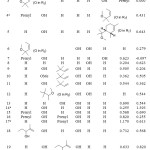 |
Table 1: Xanthone derivatives compound used as data set for QSAR analysis Click here to View table |
Instrumentation
In this study a PC with Intel® (TM)2 Quad CPU Q8200 @2.33GHz was running under a Windows XP Professional operating system. All quantum mechanical calculation was executed using Gaussian 09 software. Correlation of QSAR models was evaluated by multiple linear regression analysis using SPSS statistics 23.0. Docking studies were performed with the cDOCKER protocol under the receptor-ligand interaction section in Discovery Studio 3.1 (Accelrys, Inc., San Diego, CA, USA). Other molecular modeling software was used throughout this study including CHIMERA 1.9 and ChemOffice®.
The melting point of the synthesized compounds was determined using Electrothermal 9100 with temperature gradient 10°C/min. ESI-HRMS spectra were recorded on a BrukermicrOTOF Mass Spectrometer. Meanwhile, 1H and 13C-NMR spectra were recorded on a JEOL 500 MHz spectrometer with TMS as an internal standard. All reagents were purchased from Aldrich, Acros, and Merck and were used without further purification. All the solvents used in the synthesis were analar and synthesis grade. The solvents used in spectroscopic measurements were spectroscopic grade.
Procedure
QSAR Analysis
In order to find the best calculation method, one of the xanthone compounds (24)was calculated for 1H-NMR chemical shift using the semi-empirical method of AustinModel 1 (AM1), Parameterized Model (PM3 and PM6), and Gaussian 09 software. Thechemical shift data were then compared to the data of 1H-NMR from the experiment.AM1, PM3 or PM6 calculation methodswhich gave the closestvalues to the experimental data was selected as a method of study throughoutthe investigation.
Statistical Analysis
The predominant descriptors which affecting the antimalarial activity of the prenylatedxanthoneanalogues were selected according to the correlation analysis by SPSS 23.0 statistical software. In this process, each electronic descriptor was appointed as independent variables and pIC50 as the dependent variable. Moreover, this regression method estimates the values of the regression coefficients by applying least square curve fitting method. The model for QSAR calculation was chosen based on some statistical parameters such as r2, standard estimation of error (SEE), F-ratio between the variance of prediction and observation activity, and PRESS value (predictive residual sum of square), where: PRESS = Σ (predicted value-observed value)2,22 in criteria r2> 0.6,23; SEE < 0.3,24; Fcal/Ftab ≥ 1.25 The best-selected model obtained from the previous step was used to predict the log IC50 of the test set and the model was validated by criteria r2prediction > 0.5.26
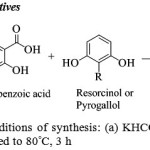 |
Scheme 1: Reagents and conditions of synthesis: (a) KHCO3, Aquadest, reflux, 4 h; (b) Eaton’s acid, heated to 80°C, 3 h Click here to View scheme |
General procedure for the synthesis of compounds 3,6-dihydroxy-9H-xanthen-9-one (26) and 3,4,6-trihydroxy-9H-xanthen-9-one (27)
A mixture of 2,4-dihydroxybenzoic acid (5 mmol) and resorcinol or pyrogallol (5 mmol) was stirred in Eaton’s acid (5 ml) and heated to 80°C for 3 h. After the completion of reaction (monitored by TLC), the product was poured into an ice water and the precipitate formed was filtered, washed with water and 5% NaHCO3. The dried product was purified by silica gel column chromatography with n-hexane/ethyl acetate (gradient 0–30% ethyl acetate) to afford compound 26 and 27.
6-dihydroxy-9H-xanthen-9-one (26)
Reddish crystals, yield 43%, mp 247°C; 1H-NMR (500 MHz, CDCl3) δ (ppm): 7.37 (d, J = 8.5 Hz, 2H), 6.37 (d, J = 8.4 Hz, 2H), 6.35 (s, 2H). HRESI-MScalcd.forC13H8O4, [M+H]+ 229.0522, found229.0517.
6-trihydroxy-9H-xanthen-9-one (27)
Reddish crystals, yield 44%, mp 254°C; 1H-NMR (500 MHz, CDCl3) δ (ppm): 7.37 (d, J = 8.5 Hz, 2H), 6.41 (d, J=8.4 Hz, 2H), 6.35 (s, 1H). HRESI-MScalcd.forC13H8O5, [M+H]+ 245.0421, found245.0411.
Molecular Docking Studies
The protein crystal structure of the inhibitor-bound DHFR was retrieved from Brookhaven Protein Data Bank (PDB codes: 1J3I). The protein was pre-treated before the docking process. Hydrogen atoms were added to the protein structure, and all ionizable residues were set at their default protonation of pH 7.2 while the ligands were prepared and minimized. During the docking process, the receptor was held rigid while the ligands were allowed to flex during the refinement. A number of polar or nonpolar receptor hotspots for conformer matching starting were set at 500 with the docking tolerance of 0.25 Å. The conformations ligands generated from the process was set to 500 within the threshold of relative energy of 20 kcal/mol.
In-vitroAntimalarial activity Assay
An in-vitro antimalarial assay was conducted against Plasmodium falciparum 3D7 strainwhich sensitive to chloroquine according to the microassay by Rieckmann et al. in 96 wellmicrotitre plates with slight modifications.27 For this assay, the compounds were dissolvedin DMSO andprepared in a series of concentration, i.e. 100, 10, 1, 0.1 and 0.01μg/mL in RPMI-1640 media. Into the sample, Parasitemia and hematocrit, ±1% and 5%were added respectively. The culture was incubated for 48 hours at 37°C, treated with 20%Giemsa dyes and made it as thin blood layer. After that, the percentage of parasitemia andalso the inhibition percentage of P. falciparum growth were determined by calculating the number of the infected erythrocytes for every 1000 erythrocytes. Based on the inhibitionpercentage data, analysis of the correlation between concentrations of the compound withthe inhibition percentage was conducted using probit log analysis to determine the IC50.
Results and Discussion
Validation method
Calculation of 1H-NMR chemical shift of compound 24 using AM1, PM3, and PM6 method showed that AM1 method was the best method, which gives the closest result to the experimental data. This result is clearly shown by the PRESS value of AM1 method (2.13) which is smaller than PM3 (3.53) and PM6 (3.57) as presented in Table 2. Therefore, AM1 method was used to calculate the descriptors of each compound.
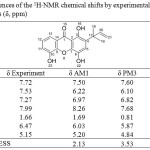 |
Table 2: The differences of the 1H‐NMR chemical shifts by experimental and computational methods (δ, ppm) Click here to View table |
Selection of the Best Model
Statistical multi-linear regression calculation of the descriptors using SPPS give 5 QSAR models as shown in Table 3. It shows that all models depict the linear correlation between biological activity and descriptors as can be seen by the r-value of each model. Basically, the best model is determined by the number of variable and statistical parameters which belong to that model.
Table 3 also show that model 4 and model 5 are considered to be the best models because those models have the lowest number of variable, the highest Fcalc/tab and the lowest PRESS (predictive residual sum of square) value. Furthermore, model 4 and 5 were used to design of new xanthones derivatives with a better antimalarial activity. The complete QSAR equations of model 4 [1] and 5 [2] are:
Log pIC50 = 67.987 (qC1) – 37.297 (qO8) – 169.104 (qC9) – 10.330 (qC12) – 127.091 (qC14) + 86.740 (qO15) – 10.827 [1]
Log pIC50 = 2.997 – 29.256 (qO8) – 138.234 (qC9) – 6.882 (qC12) – 107.836 (qC14) + 48.764 (qO15)
[2]
Table 3: Statistical model and parameter of molecular properties and antimalarial activity of xanthone derivatives
|
Model |
Variables |
r |
r2 |
Adjusted r2 |
SEE |
Fcalc/Ftable |
PRESS |
|
1 |
qC1, qO8, qC9, qC12, qC13, qC14 , qO15, EHOMO, ELUMO |
0.942 |
0.888 |
0.787 |
0.148 |
2.921 |
2.791 |
|
2 |
qC1, qO8, qC9, qC12, qC13, qC14 , qO15, EHOMO |
0.935 |
0.874 |
0.783 |
0.150 |
3.167 |
2.469 |
|
3 |
qC1, qO8, qC9, qC12, qC14 , qO15, EHOMO |
0.919 |
0.845 |
0.755 |
0.159 |
3.101 |
1.602 |
|
4 |
qC1, qO8, qC9, qC12, qC14 , qO15 |
0.904 |
0.817 |
0.733 |
0.166 |
3.207 |
0.998 |
|
5 |
qO8, qC9, qC12, qC14 , qO15 |
0.888 |
0.789 |
0.714 |
0. 172 |
3.471 |
0.921 |
Validation Model
QSAR equation [1] and [2] were used to predict antimalarial activity (log pIC50) of 5 test compounds in order to find the best model in predicting the antimalarial activity of xanthone derivatives (Table 4). The predicted antimalarial activity of 5 test set generated from model 4 and 5 was compared and then plotted with the experimental databy linear regression calculation to see the correlation for each equation, as shown in Fig. 1.
Table 4: The comparison between calculated and experimental antimalarial activity (log IC50) of 5 test set calculated by model 4 and 5
|
Comp |
Experimental (log IC50) |
Calculated (log pIC50) |
|
|
Model 4 |
Model 5 |
||
|
4 |
0.431 |
0.411 |
0.570 |
|
14 |
1.393 |
1.466 |
1.309 |
|
17 |
0.613 |
0.888 |
0.858 |
|
20 |
0.146 |
0.459 |
0.466 |
|
25 |
0.672 |
0.993 |
0.874 |
|
PRESS |
0.962 |
0.821 |
|
Table 4 shows that PRESS value of model 5 (0.821) is smaller than model 4 (0.962),which mean model 5 give a closer result to experimental data compared to model 4. Thisresult is supported by Fig. 1 where model 4 has r2 = 0.887 while model 5 has r2 = 0.963.These numbers mean that there is a significant correlation between an independent variable(in equation 2) and antimalarial activity of xanthone compound. As for model 5, the r2 value of 0.963 means the changing of independent variable (atomic charges of qO8, qC9, qC12, qC14 and qO15) could influence 96.3% of antimalarial activity (log IC50) of xanthone derivate. Therefore, itcan be concluded that model 5 is the best modelto designnew xanthone compounds with better antimalarial activity.
Furthermore, by introducing the descriptor of qC9, qC14, and qO15 as an active center ofantimalarial in xanthone derivatives, it revealed that conjugated double bond with carbonylgroup was an important feature on the antimalarial activity. This result showed thesimilarity with the reported QSAR study conducted forchalconederivatives.28
Design of New Antimalarial
Model 5 as the best QSAR model was used as a guidance to predict the antimalarial activity in the rational design of the new antimalarial compound from xanthone derivatives. R substituents were introduced to the new molecule as a descriptor which will influence the antimalarial activity. From equation 2, it can be shown that in order to get the best antimalarial activity, atomic charges of O8, C9, C12 and C14 should have a positive charge while the atomic charge of O15 should be negative. A positive charge in atom C12 can be obtained by adding electronegative substituents or donating electrons groups such as hydroxyl and halogen. Since C9 and C14 were C quarter atom which cannot be added with any R substituents, so the substituents must be bonded in C10 and C13. In order to get a positive partial charge of C9 and C14, withdrawing electron group could be added in C10 and C13 since the resonance could make an atomic charge of atom C9 and C14 becomes more positive.
The designed new antimalarial compounds of xanthone derivatives based on the best QSAR model were listed in Table 5.Indeed, this study shows that R substituents variation gives a difference antimalarial activity. It can be seen in Table 5 that there is avery significant change of the predicted antimalarial activity occurred when substituent was changedto SO3H and NO2at C10 and C13. In addition, removing of SO3H from the compound gives significant influence in decreasing the antimalarial activity. This result is similar to the previously reported study,28 that substitution of SO3H functional group is able to provide the best antimalarial activity towards chalcone compound. Meanwhile, electron donating group OH is a substituent that also gives the significant influence which leads to the better antimalarial activity.
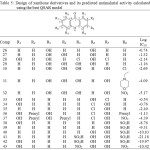 |
Table 5: Design of xanthone derivatives and its predicted antimalarial activity calculated using the best QSAR model Click here to View table |
Synthesis and an in-vitroantimalarial activity assay of compound 26 and 27 against chloroquine-sensitive 3D7 strain have been successfully conducted. The experimental antimalarial activity of 26 and 27 are close to the results from the QSAR analysis (Table 6). This result proves the accuracy of the generated QSAR equation to predict the antimalarial activity of xanthone derivatives. Also, the antimalarial activity of compound 26 and 27 could be categorized as a good antimalarial although their IC50 are slightly higher than the chloroquine as a control.
Table 6: The antimalarial activity (IC50) of compound 26 and 27 based on experimental assay and QSAR analysis.
|
Comp |
QSAR Analysis |
Data Experiment In vitro (3D7) |
||
|
Log pIC50 |
pIC50 (µg/ml) |
IC50 (µg/ml) |
IC50 (µM) |
|
|
26 |
-0.74 |
0.182 |
0.162 |
0.71 |
|
27 |
-1.32 |
0.048 |
0.027 |
0.11 |
|
CQ |
– |
– |
0.012 |
0.04 |
The active synthesized compound 26 and 27 as antimalarialwas docked to the active site of the P. falciparum DHFR crystal structure to confirm their mechanism as an antimalarial drug. Thus, the protein crystal structure of DHFR (1J3I: 2.33Å) was retrieved from Brookhaven Protein Data Bank. P. falciparum dihydrofolatereductases– thymidylate synthase (PfDHFR-TS) is an important target of antimalarial drugs.29 The inhibition of this enzyme could prevent the dTMP production and DNA synthesis since it involved in the catalysis sequential reactions in the thymidylate cycle.30 The docking studies of compounds 26 and 27 displayed favorable binding affinity towards DHFR with –cDOCKER energy shown in Table 7 and the docking interaction showed in Figure 2.
Table 7: Docking interaction of compounds 26 and 27 in Pf-DHFR-TS
|
Comp |
Wild-type Pf-DHFR-TS |
|
|
Binding interaction |
Binding Energy |
|
|
26 |
Ala16, Ser108, Phe58, Asp54, Leu46, Cys15 |
-27.586 |
|
27 |
Ala16, Ser108, Phe58, Met55, Leu46, Tyr170 |
-30.991 |
|
WR99210 |
Ala16, Ser108, Phe58, Met55, Asp54, Ile14, Ile164, Trp48, and Thr185 |
-54,3237 |
Docking studies revealed the binding site of 26 and 27 form interactions with Ala16, Ser108, Asp54, Met55, and Phe58 amino acid which is the crucial interactions for antimalarial activity based on the binding interactions displayed by the ligand co-crystal of WR99210 (1,3,5-triazine containing pre-clinical molecule as Pf-DHFR-TS inhibitor), a potent antimalarial compound. On the other hand, 26 and 27 are well-positioned in the DHFR active site, constituting of residues Ile14, Ala16, Trp48, Asp54, Met55, Phe58, Ser108, Ile164 and Thr185 (Figure 2).
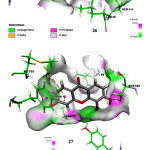 |
Figure 2: Predicted binding mode from docking simulation of 26 and 27 into the active site of P. falciparum DHFR-TS (PDB ID: 1J3I). The coloring atom for the compound is in order as follows: carbons in gray, oxygen in red, nitrogen in blue, and hydrogen in white. The green line indicates hydrogen-bonding interaction with distance ascribed in angstroms, Å. |
Conclusion
A semi-empirical molecular orbital calculation AM1 was used to study the correlation between structure and the antimalarial activity of xanthone derivatives series. Correlation of antimalarial activity with the structure has shown by atom charge of qC9, qC12, qC14 and qO15 as the active site of antimalarial. Antimalarial activity of the synthesized compounds 26 and 27 proved the relevancies between QSAR calculation and the experimental IC50 data. Molecular docking showed the binding interaction of 26 and 27 with the crucial amino acid for antimalarial activity.
Conflict of Interest Statement
We declare that we have no conflict of interest.
Acknowledgment
Authors gratitude toMinistry of Research, Technology, and Higher Education-Indonesia for the financial support of this work through competing for research project grant, contract number 92A/KONTRAK-PENELITIAN BATCH II/010/KM/2016,date February22nd, 2016 (Skim HibahBersaing). Gratitude also for Austrian‐Indonesian Centre (AIC), UniversitasGadjahMada who provided the gaussian 09 licenses. The authors alsoacknowledgethe Discovery studio 3.1 by CADD Laboratory, Faculty of Pharmacy, UniversitiKebangsaan Malaysia, for the Discovery Studio 3.1 licenses.
References
- World Health Organization. WHO Press,2015. [Online] Available fromhttp://www.who.int/malaria/publications/world-malaria-report-2015/report/en/ [Accessed on 20th August 2016].
- Fidock, D, A.; Rosenthal, P, J.; Croft, S, L.; Brun, R.; Nwaka, S. Nat. Rev. Drug Discov. 2004, 3, 509-520.
CrossRef - Ashley, E, A.;Dhorda, M.;Fairhurst, R, M.;Amaratunga, C.; Lim, P.;Suon, S.;Sreng, S.; Anderson, J, M.; Mao, S.; Sam, B.;Sopha, C.;Chuor, C, M.;Nguon, C.;Sovannaroth, S.;Pukrittayakamee, S.;Jittamala, P.;Chotivanich, K.;Chutasmit, K.;Suchatsoonthorn, C.;Runcharoen, R.;Hien, T, T.;Thuy-Nhien, N, T.;Thanh, N, V.;Phu, N, H.;Htut, Y.; Han, K, T.; Aye, K, H.;Mokuolu, O, A.;Olaosebikan, R, R.;Folaranmi, O, O.;Mayxay, M.;Khanthavong, M.;Hongvanthong, B.; Newton, P, N.;Onyamboko, M, A.;Fanello, C, I.;Tshefu, A, K.; Mishra, N.;Valecha, N.;Phyo, A, P.;Nosten, F.; Yi, P.; Tripura, R.;Borrmann, S.;Bashraheil, M.;Peshu, J.;Faiz, M, A.;Ghose, A.;Hossain, M, A.;Samad, R.;Rahman, M, R.;Hasan, M, M.; Islam, A.;Miotto, O.; Amato, R.;Maclnnis, B.; Stalker, J.; Kwiatkowski, D, P.;Bozdech, Z.;Jeeyapant, A.;Cheah, P, Y.;Sakulthaew, T.; Chalk, J.;Intharabut, B.;Silamut, K.; Lee, S, J.; Vihokhern, B.;Kunasol, C.;Imwong, M.;Tarning, J.; Taylor, W, J.;Yeung, S.; Woodrow, C, J.;Flegg, J, A.; Das, D.; Smith, J.;Venkatesan, M.;Plowe, C, V.;Stepniewska, K.; Guerin, P, J.;Dondorp, A, M.; Day, N, P.; White, N, J.Engl. J. Med.2014, 371, 411-423.
CrossRef - Upegui, Y.;Robledo, S, M.; Romero, J, F, G.;Quiñones, W.;Archbold, R.; Torres, F.; Escobar, G.; Nariño, B.;Echeverri, F. Phytother. Res. 2015, 29, 1195-1201.
CrossRef - Lyles, J, T.;Negrin, A.; Khan, S, I.; He, K.; Kennelly, E, J.Planta. Med. 2014, 80, 676–681.
- Na, Z.; Song, Q.; Hu, H. Rec. Nat. Prod.2013, 7, 220-224.
- Yuanita,E.;Pranowo, H, D.;Jumina, J.;Mustofa, M.Asian. J. Pharm. Clin. Res. 2016, 9, 180-185.
- Yang, Z, M.; Huang, J.; Qin, J, K.; Dai, Z, K.;Lan, W, L.; Su, G, F.; Tang, H.; Yang, F.Eur. J. Med. Chem.2014, 85, 487-497.
CrossRef - Fei, X.; Jo, M.; Lee, B.; Han, S, B.; Lee, K.; Jung, J, K.;Seo, S, Y.;Kwak, Y, S.Bioorg. Med. Chem. Lett.2014, 24, 2062–2065.
CrossRef - Castanheiro, R, A, P.; Silva, A, M, S.; Campos, N, A, N.;Nascimento, M, S, J.; Pinto, M, M, M.Pharmaceuticals. 2009, 2, 33-43.
CrossRef - Luo, L.; Qin, J, K.; Dai, Z, K.;Gao, S, H.J. Serb. Chem. Soc. 2013,78, 1301–1308.
CrossRef - Seca; Ana, M, L.; Leal, S, B.; Pinto, D, C, G, A.;Barreto, M, C.; Silva, A, M, S.Molecules. 2014,19, 8317-8333.
- Lee, B, W.; Lee, J, H.; Lee, S, T.; Lee, H, S.; Lee, W, S.;Jeong, T, S.; Park, K, H.Bioorg. Med. Chem. Lett. 2005, 15, 5548–5552.
CrossRef - Tang, Z, Y.; Xia, Z, X.;Qiao, S, P.; Jiang, C.;Shen, G, R.;Cai, M, X.; Tang, X, Y.Fitoterapia. 2015, 102, 109–114.
CrossRef - Zhou, Z, B.; Zhang, Y, M.;Luo, J, G.; Kong, L, Y.Phytochem. Lett.2016, 15, 215–219.
CrossRef - Deng, Y, X.; Pan, S, L.; Zhao, S, Y.; Wu, M, Q.; Sun, Z, Q.; Chen, X, H.; Shao, Z, Y.Fitoterapia. 2012, 83, 1548–1552.
CrossRef - Itoh, T.;Ohguchi, K.;Iinuma, M.;Nozawaa, Y.;Akao, Y. Bioorg. Med. Chem. 2008, 16, 4500–4508.
CrossRef - Mahendran, G.; Manoj, M.;Murugesh, E.; Kumar, R, S.;Shanmughavel, P.; Prasad, K, J, R.;Bai, V, N. Phytomedicine.2014, 21, 1237–1248.
CrossRef - Amanatie;Jumina;Mustofa;Hanafi, M.;Armunanto, R. Indo. J. Chem. 2010, 10, 357-362.
- Hay, A, E.;Helesbeux, J, J.; Duval, O.;Labaied, M.;Grellier, P.;Richomme, P. Life. Sci. 2004, 75, 3077-3085.
CrossRef - Marti, G.;Eparvier, V.;Litaudon, M.;Grellier, P.;Gueritte, F. Molecules, 2010, 15, 7106-7114.
CrossRef - Podunavac-Kuzmanovic, S, O.;Cvetkovic, D, D.;Barna, D, J. Int. J. Mol. Sci. 2009, 10, 1670-1682.
- Golbraikh, A.;Shen, M.; Xiao, Z.; Xiao, Y, D.; Lee, K, H.;Tropsha, A.J. Comput. Aided. Mol. Des. 2003, 17, 241-253.
CrossRef - Modak, V, P.;Pathak, H.; Thayer, M.; Singer, S, J.;Wyslouzil, B, E. Phys. Chem. Chem. Phys. 2013,15, 6783-6795.
CrossRef - Motta, L, F.; Almeida, W, P. Int. J. Drug. Disc. 2011, 3, 100-117.
- Frimayanti, N.; Yam, M, L.; Lee, H, B.; Othman, R.;Zain, S, M.;Rahman, N, A. Int. J. Mol. Sci. 2011, 12, 8626‑8644.
CrossRef - Rieckmann, K, H.; Sax, L, J.; Campbell, G, H.;Mrema, J, E. Lancet.1978, 311, 22-23.
CrossRef - Syahri, J.;Purwono, B.;Armunanto, R. Int. J. Pharm. Sci. Rev. Res. 2016, 36, 71‐76.
- Yuvaniyama, J.;Chitnumsub, P.;Kamchonwongpaisan, S.;Vanichtanankul, J.;Sirawaraporn, W.; Taylor, P.;Walkinshaw, M, D.;Yuthavong, Y. Nat. Struct. Biol. 2003, 10, 357-365.
CrossRef - Ferone, R. Bull. World. Health. Organ.1977,55, 291-298.

This work is licensed under a Creative Commons Attribution 4.0 International License.









